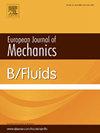Instability in heated water-porous system
IF 2.5
3区 工程技术
Q2 MECHANICS
引用次数: 0
Abstract
This paper investigates the stability in a heated fluid-porous system. Darcy’s law is used for the flow in the porous medium. Previous studies indicate that the classical Rayleigh–Bénard instability in this flow is independent of the mutual positions of the fluid layer and porous layer. This paper demonstrates that the instability depends on the mutual positions of the fluid layer and porous layer when the liquid density is nonlinearly dependent on temperature. When porous medium is located at the bottom of the system, onset of convection may occur in lower porous layer (pure-porous mode), upper water layer (pure-water mode) or across both layers (porous-water mode). However, onset of convection cannot take place only in the upper porous layer when porous medium is placed at the top of the system. The influence of depth ratio and the density inversion parameter on instability of bilayer system are investigated in detail and dependence of critical modes on parameters are summarized in phase diagrams. In addition, direct numerical simulation is used to analyse the instability mechanism and identify subcritical or supercritical instability for bilayer systems.
加热水-多孔系统的不稳定性
本文研究了加热流体-多孔系统中的稳定性。多孔介质中的流动采用达西定律。以往的研究表明,这种流动中的经典瑞利-贝纳德不稳定性与流体层和多孔层的相互位置无关。本文证明,当液体密度与温度非线性相关时,不稳定性取决于流体层和多孔层的相互位置。当多孔介质位于系统底部时,对流可能发生在下部多孔层(纯多孔模式)、上部水层(纯水模式)或横跨两层(多孔-水模式)。然而,当多孔介质位于系统顶部时,对流不可能只在上层多孔层发生。详细研究了深度比 dˆ 和密度反转参数 θM 对双层体系不稳定性的影响,并通过相图总结了临界模式对参数的依赖性。此外,还利用直接数值模拟分析了双层体系的不稳定性机理,并确定了亚临界或超临界不稳定性。
本文章由计算机程序翻译,如有差异,请以英文原文为准。
求助全文
约1分钟内获得全文
求助全文
来源期刊
CiteScore
5.90
自引率
3.80%
发文量
127
审稿时长
58 days
期刊介绍:
The European Journal of Mechanics - B/Fluids publishes papers in all fields of fluid mechanics. Although investigations in well-established areas are within the scope of the journal, recent developments and innovative ideas are particularly welcome. Theoretical, computational and experimental papers are equally welcome. Mathematical methods, be they deterministic or stochastic, analytical or numerical, will be accepted provided they serve to clarify some identifiable problems in fluid mechanics, and provided the significance of results is explained. Similarly, experimental papers must add physical insight in to the understanding of fluid mechanics.

 求助内容:
求助内容: 应助结果提醒方式:
应助结果提醒方式:


